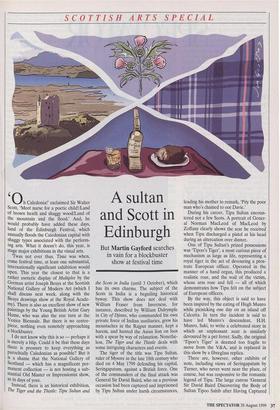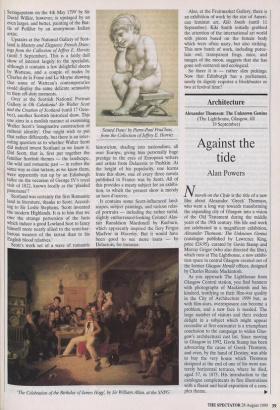SCOTTISH ARTS SPECIAL
A sultan and Scott in Edinburgh
But Martin Gayford searches in vain for a blockbuster show at festival time Oh Caledonia!' exclaimed Sir Walter Scott, 'Meet nurse for a poetic child!/Land of brown heath and shaggy wood/Land of the mountain and the flood.' And, he would probably have added these days, land of the Edinburgh Festival, which annually floods the Caledonian capital with shaggy types associated with the perform- ing arts. What it doesn't do, this year, is stage major exhibitions in the visual arts.
'Twas not ever thus. Time was when, come festival time, at least one substantial, internationally significant exhibition would Open. This year the closest to that is a rather esoteric display of Multiples by the German artist Joseph Beuys at the Scottish National Gallery of Modem Art (which I shall discuss next week, along with the Beuys drawings show at the Royal Acade- my). There is also an excellent show of new Paintings by the Young British Artist Gary Hume, who was also the star turn at the Venice Biennale. But there is no centre- piece, nothing even remotely approaching a blockbuster.
I do not know why this is so — perhaps it is merely a blip. Could it be that these days there is pressure to keep everything as parochially Caledonian as possible? But it is a shame that the National Gallery of Scotland — which has a magnificent per- manent collection — is not hosting a sub- stantial Old Master or Impressionist show, as in days of yore. Instead, there is an historical exhibition, The Tiger and the Thistle: Tipu Sultan and the Scots in India (until 3 October), which has its own charms. The subject of the Scots in India is a beguiling historical byway. This show does not deal with William Fraser from Inverness, for instance, described by William Dalrymple in City of Djinns, who commanded his own private force of Indian auxiliaries, grew his moustaches in the Rajput manner, kept a harem, and hunted the Asian lion on foot with a spear by way of relaxation. Nonethe- less, The Tiger and the Thistle deals with some intriguing characters and events.
The tiger of the title was Tipu Sultan, ruler of Mysore in the late 18th century who died on 4 May 1799 defending his capital, Seringapatam, against a British force. One of the commanders of the final attack was General Sir David Baird, who on a previous occasion had been captured and imprisoned by Tipu Sultan under harsh circumstances, leading his mother to remark, 'Pity the poor man who's chained to oor Davie.'
During his career, Tipu Sultan encoun- tered not a few Scots. A portrait of Gener- al Norman MacLeod of MacLeod by Zoffany clearly shows the scar he received when Tipu discharged a pistol at his head during an altercation over dinner.
One of Tipu Sultan's prized possessions was `Tipoo's Tiger', a most curious piece of mechanism as large as life, representing a royal tiger in the act of devouring a pros- trate European officer. Operated in the manner of a hand organ, this produced a realistic roar, and the wail of the victim, whose arm rose and fell — all of which demonstrates how Tipu felt on the subject of European officers.
By the way, this object is said to have been inspired by the eating of Hugh Munro while picnicking one day on an island off Calcutta. In turn the incident is said to have led Munro's descendent, H.H. Munro, Saki, to write a celebrated story in which an unpleasant aunt is similarly devoured by a pet ferret. Sadly, the original `Tipoo's Tiger' is deemed too fragile to move from the V&A, and is replaced in this show by a fibreglass replica.
There are, however, other exhibits of note, including views of Seringapatam by Turner, who never went near the place, of course, but was responsive to the romantic legend of Tipu. The large canvas 'General Sir David Baird Discovering the Body of Sultan Tipoo Sahib after Having Captured Seringapatam on the 4th May 1799' by Sir David Wilkie, however, is upstaged by an even larger, and better, painting of the Bat- tle of Pollilur by an anonymous Indian artist.
Upstairs at the National Gallery of Scot- land is Mastery and Elegance: French Draw- ings from the Collection of Jeffrey E. Horvitz (until 5 September). This is a fairly dull show of interest largely to the specialist, although it contains a few delightful sheets by Watteau, and a couple of nudes by Charles de la Fosse and Le Moyne showing that some of Watteau's contemporaries could display the same delicate sensuality in their off-duty moments. Over at the Scottish National Portrait Gallery is Oh Caledonia! Sir Walter Scott and the Creation of Scotland (until 17 Octo- ber), another Scottish historical show. This one aims in a modish manner at examining Walter Scott's 'imaginative construction of cultural identity'. One might wish to put that rather differently, but there is an inter- esting question as to whether Walter Scott did indeed invent Scotland as we know it. Did Scott, that is, first put together the familiar Scottish themes — the landscape, the wild and romantic past — in rather the same way as clan tartans, as we know them, were apparently run up by an Edinburgh tailor on the occasion of George IV's royal visit of 1822, known locally as the 'plaided panorama'?
Scotland was certainly the first Romantic land in literature, thanks to Scott. Accord- ing to Sir Leslie Stephens, 'Scott invented the modern Highlands. It is to him that we owe the strange perversion of the facts which induce a good Lowland Scot to fancy himself more nearly allied to the semi-bar- barous wearers of the tartan than to his English blood relatives.'
Scott's work set of a wave of romantic 'Seated Pinto' by Pierre-Paul Prud'lion, from the Collection of Jeffrey E. Horvitz historicism, shading into nationalism, all over Europe, giving him personally huge prestige in the eyes of European writers and artists from Delacroix to Pushkin. At the height of his popularity, one learns from this show, one of every three novels published in France was by Scott. All of this provides a meaty subject for an exhibi- tion, to which the present show is merely an hors d'oeuvre.
It contains some Scott-influenced land- scapes, subject paintings, and various relat- ed portraits — including the rather stolid, slightly embarrassed-looking Colonel Alas- tair Ranaldson Macdonell by Raeburn, which apparently inspired the fiery Fergus Maclvor in Waverley. But it would have been good to see more loans — by Delacroix, for instance.
`The Celebration of the Birthday of James Hogg, by Sir William Allan, at the SNPG
Also, at the Fruitmarket Gallery, there is an exhibition of work by the star of Ameri- can feminist art, Kiki Smith (until 11 September). Kiki Smith initially grabbed the attention of the international art world with pieces based on the female body which were often nasty, but also striking. This new batch of work, including porce- lain owl, transparent frogs, mice, and images of the moon, suggests that she has gone soft-centered and ecological.
So there it is — rather slim pickings. Now that Edinburgh has a parliament, surely its dignity requires a blockbuster or two at festival time?



























































 Previous page
Previous page